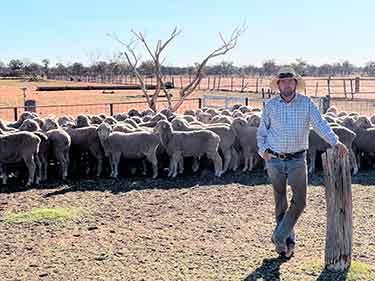
Anthony Glasson, Picarilli Merinos, Thargomindah, breeds Merino rams to produce profitable dual purpose sheep in Australia’s toughest low rainfall environments. Image Picarilli
Maximising lamb survival and marking rates in paddocks of up to 20,000 acres (8097ha) in a low rainfall environment is no easy feat but the Glasson family is all about pushing the envelope on performance and profit.
Picarilli Merinos is operated by Anthony and Gerda Glasson across an aggregation of 109,000ha in 250mm rainfall country near Thargomindah in some of the toughest country in Queensland.
In fact, Picarilli is the last remaining Merino sheep flock in the Bulloo Shire and supplies flock rams into low rainfall environments of central western Queensland and NSW northwest slopes and plains.
The Glassons will offer 80 selected commercial rams at Picarilli Station, Thargomindah, at an open cry auction interfaced with FarmGate Auctions on September 26 at 12pm. Data on weaning and yearling weight, horn status, scrotal circumference, micron, staple length, fleece weight and wool traits is available. After the sale120 grade rams will be offered by private treaty.
Mr Glasson said Picarilli aims to breed highly profitable, easy care, bare breech Merinos producing a long staple of bright, lustrous, deep crimping wool with exceptional comfort factor.
This year, the draft of 230 rams had an average comfort factor of 99.68, standard deviation of 2.8 and coefficient of variation 16.5.
Mr Glasson said an injection of Glenwood genetics in the last three years resulted in defined crimping, lustrous wool to build on genetically superior fat and muscle carcase traits from Mumblebone sires.
Picarilli has selected for bare breech and was able to cease mulesing wethers in 2005 and the entire flock in 2007, and have been pregnancy scanning ewes since 2005 to place pressure on fertility.
The ewes must survive and rear a lamb each year on native pasture with no crops or grain feeders.
Picarilli breeder ewes peaked in 2021 marking 4500 lambs and last year made room for 300 maiden ewes to join the ram breeding nucleus. The family is running a total of 3500 stud and flock spring lambing ewes.
The adult ewes average 19.5-20 micron with an average fleece weight of 5.5kg.
“We are focusing on slowly and carefully reducing the average micron to 18.5-19 without losing any wool cut by selecting sires with a lower micron and top end fleece weight,” Mr Glasson said.
“We will be cautious not to do it at the detriment of other economically important traits.
“Fat and muscle continue to be our big profit driver with body condition the key. Sheep with superior genetics for fat and muscle are the first to recover from a stressful event, whether that be heavy rain, drought or multiple lambs, and return to a good body condition score ready for joining.”
The Picarrilli sheep are bred for bright, white wools with a defined crimp and lustre.
“Nourishment keeps a bit of weight on the wool and the dust out in this dry environment,” Mr Glasson said.
“We haven’t mulesed for 16 years resulting in an easy care, straight bodied, bare breech animal.
“We are really targeting that sheep with above average fleece weights and bright, white wool.
“Fertility has always been our big driving focus with lamb marking rates of 161 per cent in the twin bearing ewes last year.”
It is an impressive result considering the ewes are lambing in paddocks from 2024 to 8097ha in size.
“This year all ewes, included maidens, scanned with a conception rate of 94 per cent and 134 per cent foetuses to ewes joined across a five-week joining, placing selection pressure on them to bring the elite ewes for fertility to the surface,” Mr Glasson said.
“With the scanned-in-lamb single ewes, we aim to mark 95-98 per cent while we target 150 per cent plus with the twin bearing ewes.
“This year there was 1160 multiple bearing ewes and they were split into two mobs lambing in 2024ha paddocks each with plenty of space. The size of the paddock and number of watering points is as important as the number of sheep.
“Plenty of water and space means they are not coming together in big mobs regularly, reducing the chance of mismothering.”
Consistent predator management and exclusion fencing also increases lamb survival.
Easy care, plain bodied and medium framed cast-for-age and cull Picarilli ewes dressed at 24.6kg when turned off this year while 12-month-old wether lambs, June shorn and finished on native pastures, sold over the hooks to dress at 23.8kg to return $118.
The nine-month-old ram lambs were shorn in May 2023 with 5.5 months wool growth and running on native pasture averaged 16.8 micron, 80mm staple length and 2.4kg fleece weight. Their average scrotal circumference was 26cm.
Although just 110mm has fallen since January, the young rams have performed well on the winter herbage.
Picarilli traditionally sells rams into Muttaburra, Longreach, Stonehenge, Quilpie, Wanaaring, St George, Thallon and Narrabri.
Mr Glasson said client feedback revealed there was no issues with colour or fleece rot during the unseasonably wet weather in northern NSW in 2022.
The family’s stock agent, Steve Mauder, LRW Rural, suggested Picarilli use FarmGate Auctions as their online selling platform and last year cleared 99 per cent, topped at $2800 and averaged $1352 – up 82 per cent on the previous year.
Mr Glasson liked the idea of healthy competition in the market and was impressed with the seamless experience of selling rams with FarmGate Auctions.
“It gives people who for one reason or another they can’t make the sale and can still jump on line to bid on ramsfrom home and secure the rams they want.
“We have a lot to offer commercial wool growers in the regions north of here and I am really excited to provide rams bred for those tougher environments.”
For further details visit www.picarilli.com.au or www.farmgateauctions.com.au
